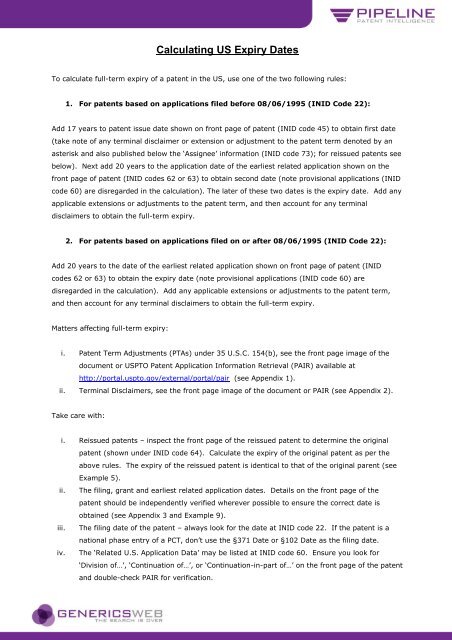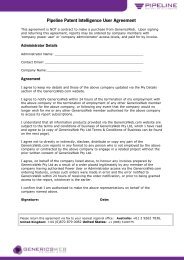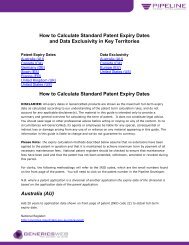Calculating US Expiry Dates - GenericsWeb
Calculating US Expiry Dates - GenericsWeb
Calculating US Expiry Dates - GenericsWeb
You also want an ePaper? Increase the reach of your titles
YUMPU automatically turns print PDFs into web optimized ePapers that Google loves.
<strong>Calculating</strong> <strong>US</strong> <strong>Expiry</strong> <strong>Dates</strong><br />
To calculate full-term expiry of a patent in the <strong>US</strong>, use one of the two following rules:<br />
1. For patents based on applications filed before 08/06/1995 (INID Code 22):<br />
Add 17 years to patent issue date shown on front page of patent (INID code 45) to obtain first date<br />
(take note of any terminal disclaimer or extension or adjustment to the patent term denoted by an<br />
asterisk and also published below the ‘Assignee’ information (INID code 73); for reissued patents see<br />
below). Next add 20 years to the application date of the earliest related application shown on the<br />
front page of patent (INID codes 62 or 63) to obtain second date (note provisional applications (INID<br />
code 60) are disregarded in the calculation). The later of these two dates is the expiry date. Add any<br />
applicable extensions or adjustments to the patent term, and then account for any terminal<br />
disclaimers to obtain the full-term expiry.<br />
2. For patents based on applications filed on or after 08/06/1995 (INID Code 22):<br />
Add 20 years to the date of the earliest related application shown on front page of patent (INID<br />
codes 62 or 63) to obtain the expiry date (note provisional applications (INID code 60) are<br />
disregarded in the calculation). Add any applicable extensions or adjustments to the patent term,<br />
and then account for any terminal disclaimers to obtain the full-term expiry.<br />
Matters affecting full-term expiry:<br />
i. Patent Term Adjustments (PTAs) under 35 U.S.C. 154(b), see the front page image of the<br />
document or <strong>US</strong>PTO Patent Application Information Retrieval (PAIR) available at<br />
http://portal.uspto.gov/external/portal/pair (see Appendix 1).<br />
ii. Terminal Disclaimers, see the front page image of the document or PAIR (see Appendix 2).<br />
Take care with:<br />
i. Reissued patents – inspect the front page of the reissued patent to determine the original<br />
patent (shown under INID code 64). Calculate the expiry of the original patent as per the<br />
above rules. The expiry of the reissued patent is identical to that of the original parent (see<br />
Example 5).<br />
ii. The filing, grant and earliest related application dates. Details on the front page of the<br />
patent should be independently verified wherever possible to ensure the correct date is<br />
obtained (see Appendix 3 and Example 9).<br />
iii. The filing date of the patent – always look for the date at INID code 22. If the patent is a<br />
national phase entry of a PCT, don’t use the §371 Date or §102 Date as the filing date.<br />
iv. The ‘Related U.S. Application Data’ may be listed at INID code 60. Ensure you look for<br />
‘Division of…’, ‘Continuation of…’, or ‘Continuation-in-part of…’ on the front page of the patent<br />
and double-check PAIR for verification.
DISCLAMIER: All <strong>US</strong> expiry dates in <strong>GenericsWeb</strong> products are shown as the maximum full-term<br />
expiry date as calculated manually according to our understanding of the patent term calculation<br />
rules, and do not account for any applicable terminal disclaimer(s). The material in this guide is<br />
intended only to provide a summary and general overview for calculating the term of patent under<br />
current <strong>US</strong> Patent Law. It does not constitute legal advice. You should seek legal or other<br />
professional advice before acting or relying on any of the content. In no circumstances will<br />
<strong>GenericsWeb</strong>, its agents or employees be liable for any special, consequential or indirect loss or<br />
damage arising from any use of or reliance on any material appearing in this guide. The information<br />
in this guide is liable to change and we do not guarantee its currency.<br />
In the following examples, for the sake of brevity, all the information on the front page of the patent<br />
has already been verified and has been determined to be accurate and comprehensive by use of PAIR<br />
(see Example 9 to understand how this verification was carried out).<br />
Note: Date format DD/MM/YYYY is used throughout.<br />
Example 1.<br />
[22] = 23/03/1984, thus use Rule 1. No related application, thus use [22] filing date + 20 years =<br />
23/03/2004.<br />
[45] = 28/03/1989 + 17 years = 28/03/2006.<br />
<strong>Expiry</strong> is the later of the two dates, thus full-term expiry is 28/03/2006.
Example 2.<br />
[22] = 23/10/1996, thus use Rule 2. No related application, thus use [22] filing date + 20 years =<br />
23/10/2016.<br />
Thus full-term expiry is 23/10/2016.<br />
Example 3.<br />
[22] = 06/06/1995, thus use Rule 1. Earliest related application + 20 years = 04/08/2009.<br />
[45] = 12/08/1997 + 17 years = 12/08/2014.<br />
<strong>Expiry</strong> is the later of the two dates, thus full-term expiry is 12/08/2014.
Example 4.<br />
[22] = 04/06/1996, thus use Rule 2. Earliest related application + 20 years = 04/08/2009.<br />
Thus full-term expiry is 04/08/2009.<br />
Example 5.<br />
[64] = Reissue of <strong>US</strong>4943590, thus full-term expiry of <strong>US</strong>RE34712 is identical to the full-term expiry<br />
of <strong>US</strong>4943590. To calculate the full-term expiry of <strong>US</strong>4943590, refer to the front page of the patent<br />
directly.
[22] = 08/06/1989, thus use Rule 1. No related application, thus use [22] filing date + 20 years =<br />
08/06/2009.<br />
[45] = 24/07/1990 + 17 years = 24/07/2007.<br />
<strong>Expiry</strong> is the later of the two dates, thus full-term expiry is 08/06/2009.<br />
Example 6.
[22] = 12/12/2001, thus use Rule 2. Earliest related application + 20 years = 07/07/2020.<br />
Note the asterisk (*) near the grant issue date [45] and the corresponding information on the front<br />
page published below the ‘Assignee’ information (INID code 73) indicating a terminal disclaimer has<br />
been filed as well as 0 days PTA.<br />
Upon inspection of disclaimer information for this record in PAIR, it reveals the patent would not<br />
extend beyond the expiration date of <strong>US</strong>6960613 (see Appendix 2). It also confirmed in PAIR that<br />
the PTA is 0 days (see Appendix 1).<br />
The full term expiry of <strong>US</strong>6960613 is calculated below:<br />
[22] = 20/08/2003, thus use Rule 2. Earliest related application + 20 years = 07/07/2020.<br />
Thus full-term expiry is 07/07/2020 plus 0 days PTA, with expiry not exceeding 07/07/2020 =<br />
07/07/2020.
Example 7.<br />
[22] = 10/01/2002, thus use Rule 2. Earliest related application + 20 years = 18/03/2011.<br />
Note: ‘Related U.S. Application Data’ is listed at INID code 60.<br />
Note there is no asterisk (*) near the grant issue date [45], however there is an asterisk on the front<br />
page published below the ‘Assignee’ information (INID code 73) indicating PTA of 334 days is<br />
applicable.<br />
Upon inspection of the PTA for this record in PAIR, it is confirmed that the PTA is 334 days (see<br />
Appendix 1).<br />
Thus full-term expiry is 18/03/2011 plus 334 days PTA = 15/02/2012.
Example 8.<br />
[22] = 06/02/2004, thus use Rule 2. Earliest related application + 20 years = 18/03/2011.<br />
Note: ‘Related U.S. Application Data’ is listed at INID code 60.<br />
Note the asterisk (*) near the grant issue date [45], and the corresponding information on the front<br />
page published below the ‘Assignee’ information (INID code 73 indicating a terminal disclaimer has<br />
been filed as well as indication of a PTA of 486 days.<br />
Upon inspection of disclaimer information for this record in PAIR, it reveals the patent would not<br />
extend beyond the expiration date of <strong>US</strong>6284471, <strong>US</strong>6790444, <strong>US</strong>7070775 or <strong>US</strong>7276239 (see<br />
Appendix 2). It also confirmed in PAIR that the PTA is 486 days (see Appendix 1).
For the sake of brevity, the full-term expiry of the patents was calculated to be:<br />
<strong>US</strong>6284471 = 18/03/2011<br />
<strong>US</strong>6790444 = 11/07/2011<br />
<strong>US</strong>7070775 = 11/07/2011<br />
<strong>US</strong>7276239 = 18/03/2011<br />
Thus full-term expiry is 18/03/2011 plus 486 days PTA, with expiry not exceeding 18/03/2011 =<br />
18/03/2011.<br />
Example 9.<br />
Any good researcher understands the need to verify data across many sources to confidently finalise<br />
any expiry date. A common error on the front page image of <strong>US</strong> patents is the incorrect listing of<br />
‘Related U.S. Application Data’ (INID codes 62 or 63), for example, the earliest related application<br />
may not be the earliest per se. Verifying the earliest related application information on every<br />
occasion is critical to obtaining an accurate expiry date. Verification of other information (application<br />
date, grant date, etc.) via INPADOC, PAIR, etc. is also critical.<br />
[22] = 15/05/1998, so use Rule 2. Earliest related application + 20 years = 07/11/2017 (provisional<br />
applications are not considered).<br />
Thus full-term expiry is 07/11/2017. But is it?<br />
Let’s check…
Application 08/965,922 is now patent <strong>US</strong>5972967. Inspection of this patent reveals:<br />
This patent is a divisional of another application, namely 08/735,878 now patent <strong>US</strong>5733919.<br />
Inspection of <strong>US</strong>5733919 reveals that it is the earliest related application in this family and thus the<br />
earliest related application date is 23/10/1996.<br />
Thus full-term expiry is actually = 23/10/2016.<br />
You can also verify related application data in PAIR via the ‘Continuity Data’ tab (see Appendix 3).
Appendix 1 – Finding PTAs in PAIR.<br />
Enter the captcha image in the PAIR welcome screen and enter the number into the search screen.<br />
To enter a ‘Patent Number’ use format NNNNNNN or N,NNN,NNN (e.g. 5972967 or<br />
5,972,967)<br />
To enter an ‘Application Number’ use format NN/NNNNNN (e.g. 07/902500)<br />
To enter a ‘Publication Number’ i.e. a published <strong>US</strong> patent application use YYYY0NNNNNN<br />
Click on the ‘Patent Term Adjustments’ or ‘Patent Term Extensions’ tab.<br />
Verify the number of days a patent has been adjusted for in the ‘Total PTA Adjustments’ field.
Appendix 2 – Finding Terminal Disclaimers in PAIR.<br />
If a Terminal Disclaimer is referenced on the front page image of a document, you can consult PAIR<br />
to find the details of the portion disclaimed.<br />
Follow the instruction in Appendix 1 to access registry information in PAIR.<br />
Click on the ‘Image File Wrapper’ tab, look in the ‘Document Code’ column for ‘DISQ’ (disclaimer<br />
filing) or ‘DIST’ (disclaimer decision) or search for ‘disclaim’ on the page (note that there may be<br />
more than one disclaimer for each patent). Inspect all of the terminal disclaimers and note all the<br />
patent and/or application numbers referenced (an extracted example is pasted below). The<br />
maximum full-term expiry of the patent is equal to the earliest expiry of the referenced patents.<br />
Note: the ‘Image File Wrapper’ tab is not always freely available in PAIR, but you can order the file<br />
wrapper by clicking ‘Order Certified File Wrapper’ at the top of the page.<br />
Terminal Disclaimers get complicated when s156 patent term extensions (PTEs) are applied, consult<br />
http://en.wikipedia.org/wiki/Term_of_patent_in_the_United_States#Terminal_disclaimer for<br />
reference.
Appendix 3 – Verifying data in PAIR.<br />
Follow the instruction in Appendix 1 to access registry information in PAIR.<br />
You will be directed to the ‘Application Data’ tab. Here you can verify the filing date [22] (‘Filing or<br />
371(c) Date’) and the grant issue date [45] (‘Issue Date of Patent’). Again, take special care with<br />
the ‘Filing or 371(c) Date’ to ensure you are verifying and obtaining the filing date of the patent and<br />
not the 371(c) national phase receipt date.<br />
Verification of the related applications is done via the ‘Continuity Data’ tab. It details both parent<br />
continuity data (information on what the patent is a continuation/division/continuation-in-part of) as<br />
well as child continuity data (information on what patents claim the benefit of the application).<br />
Drill down through the continuation history to verify the earliest related application date.





